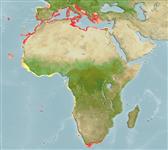Common names from other countries
Environment: milieu / climate zone / depth range / distribution range
Οικολογία
; εύρος βάθους 1 - 110 m (Ref. 85345). Subtropical; 46°N - 37°S, 26°W - 32°E
Eastern Atlantic and the Mediterranean.
Length at first maturity / Μέγεθος / Βάρος / Age
Maturity: Lm ? range ? - ? cm Max length : 60.0 cm WD αρσενικό/απροσδιόριστο; (Ref. 114251)
Maximum length is in body diameter (Ref. 114251). Infaunal; found on sandy substrates (Refs 106821, 106822). Common on bottoms covered with seagrasses and also occurs on detritic and muddy bottoms (Ref. 106822). Main diet include gastropods and bivalves (Ref. 106164).
Life cycle and mating behavior
Γεννητική Ωρίμανση | Αναπαραγωγή | Γεννοβολία | Αβγά | Γονιμότητα | Προνύμφες
Members of the class Asteroidea exhibit both asexual (regeneration and clonal) and sexual (gonochoric) means of reproduction. Life cycle: Embryos hatch into planktonic larvae and later metamorphose into pentamorous juveniles which develop into young sea stars with stubby arms.
MarineSpecies.org. 2050. (Ref. 3477)
IUCN Red List Status (Ref. 130435)
CITES status (Ref. 108899)
Not Evaluated
Not Evaluated
Threat to humans
Harmless
Human uses
| FishSource |
Εργαλεία
Περισσότερες πληροφορίες
Age/Size
Αύξηση
Length-weight
Length-length
Μορφολογία
Προνύμφες
Αφθονία
Διαδικτυακές πηγές
Estimates based on models
Preferred temperature
(Ref.
115969): 14.3 - 21, mean 18.2 (based on 276 cells).
